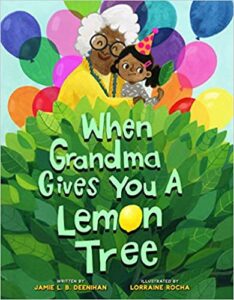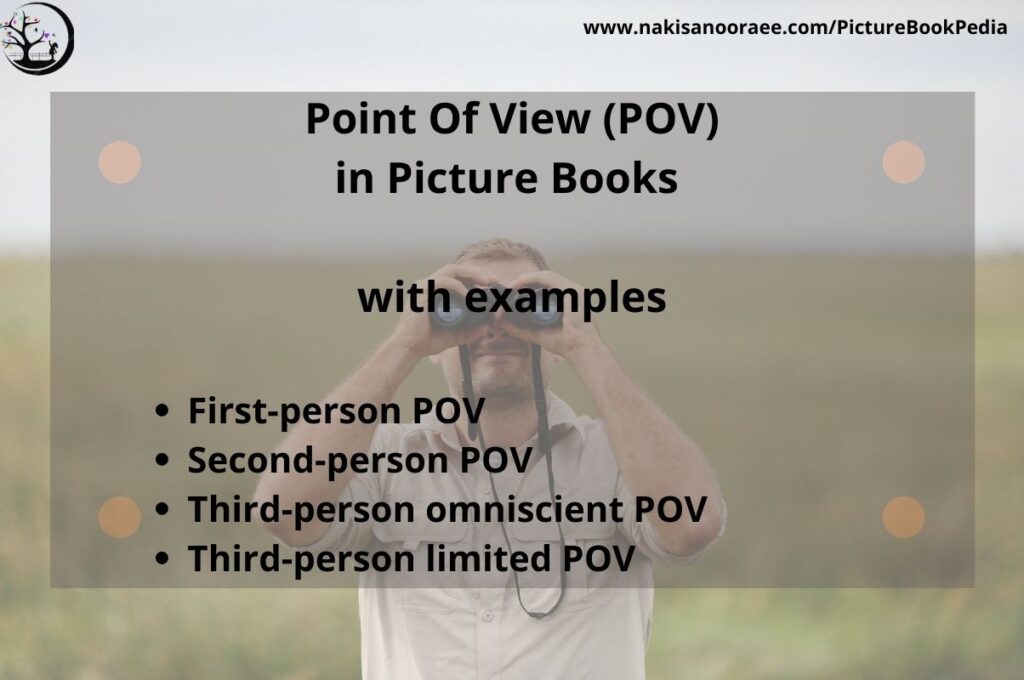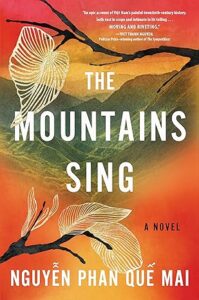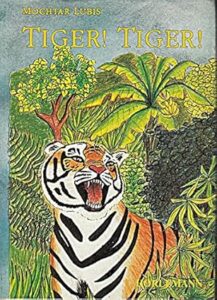In the previous blog post, we went through basic definitions of Point Of View (POV). This blog post is about each type of POV with a picture book example.
First-person POV
The first-person POV has the shortest Narrative Distance because the Narrator, from inside the story world, directly shares her feelings and observations with the reader. The shorter the Narrative Distance, the deeper the feelings.
However, there is a trade-off between intimacy and knowledge. With the first-person POV, the story tells only as far as the Narrator understands and knows the story. Sometimes it becomes harder to keep the suspense in the story with the first-person POV, if the Narrator knows something that you want to reveal at the end of the story!
For example, of a first-person POV in a picture book, let’s consider the story of The Secret Fawn (2021), by Kallie George.
The story starts when the family sees a deer in the garden. All except for the Narrator:
Reading a story with first-person POV puts the reader immediately in the head of the Narrator; We know how the Narrator feels—she is upset not only because she didn’t see the deer but also because of missing everything! Always!
Caution: There is one more issue about the first-person POV; the story is prone to spend many pages in the head of the Narrator. You may have read manuscripts that the Narrator only thinks and thinks and again thinks, and nothing happens outside! Keeping the balance between events outside of the Narrator and thoughts inside her head is tricky.
First-person-plural POV
Two Grooms on a Cake: The Story of America’s First Gay Wedding (2021) by Rob Sanders and Robbie Cathro is written in first-person plural POV (you see the pronoun we, ours, etc). On youtube, you can watch Rob sanders read aloud his book.

Second-person POV
An important caution about the second-person POV is that a text which has “you do this” and “you do that” is NOT necessarily a second-person POV. Many non-fiction and how-to books use second-person pronouns to communicate with their audience. Titles like “How to babysit your ….”, “How to train your …”, etc are humorful picture books belonging to the non-fiction category.
To have a second-person POV in fiction, the text SHOULD have the narrative elements; a narrative structure (beginning-middle-end or Act I-Act II- Act III) and a Character Arc, then you have got a narrator who tells the story.
Let’s see an example: When Grandma Gives you a Lemon Tree (2019) by Jamie L.B. Deenihan. The story has a narrative structure: the Inciting Event is when a girl receives a lemon tree as a birthday gift, and she is, not surprisingly, annoyed. Now, she has to look after the tree (middle or Act-II). 
The story has a character arc also; the Protagonist (the girl) is initially unhappy with receiving the lemon tree as her birthday gift, and if you look at the illustration of the first spread and the Protganoist’s wishlist, you notice that whatever she wants is for herself—normal for her age. However, at the end of the story, the Protagonist buys many planets and small trees to plant them and share her happiness with others. She has changed. Such a perfect example of a positive character arc!
Now that we examined the two most important elements of fiction in this book, let’s look at Narrator and the POV. The Narrator is the Protagonist (the girl) and she uses the pronoun you to tell the story:
Writing picture books in the second-person POV has a big advantage: picture book has to be read to children and when the aloud-reader reads the book, it feels like speaking to the child, not reading a book.
Third-person POV
There are three types of third-person POV. In the table below, a comparison between them is given.

Third-person omniscient POV
The word omniscient consists of two Latin words: omni means “all” and scientia means “knowledge”. A third-person omniscient POV is a god-like all-knowing entity that can get into the mind and the thoughts of all characters! This type of POV was common in 19-century literature. Nowadays? Not very frequent. The most important reason is the Narrative Distance; In 21-century books are not Proustian anymore. With the 300-400 pages book, you don’t have space to explain the thoughts and feelings of all characters; even though the omniscient POV knows all! Thus, the reader doesn’t feel close to any of the characters! In other words, the Narrative Distance is very wide.
Frog and Toad are Friends (1979) by Arnold Lobel is an example of this POV type. The Narrator watches the story from above like a camera zoomed out. 
Third-person objective POV
This type of POV is the exact opposite of the omniscient POV. As the name of this POV tells, all details should be objective, like a camera installed in a public place, recording people’s behavior. Look at the example in the table above and the verbs. They report what you can see and understand from a person’s behavior. Feelings, emotion, and thoughts, if has no physical appearance, have no place in this POV.
This type of POV is distanced and impersonal and suits more thriller or mystery novels.
Third-person Subjective (limited) POV
What if an all-knowing Narrator focuses only on one character, gets into his/her mind and tells the story through the eye of the character, and reveals his/her feelings and thoughts for the reader?
Here comes a very useful term which prevents many confusions. In the limited POV, the Narrator is a neutral observer outside of the story world who tells the story by getting into the head of one character from inside the story. Some call this character Point Of View Character (POVC).
The advantage of this POV is that reader gets closer to one character (aka. POVC) and the Narrative Distance is shorter. The question is which character would be the best choice for POVC? The answer, as always, depends on the story.
The third-person limited POV is one of the most favorite POVs in literature and picture books are no exception. Tell the story from the POV of the child character and children relate to the story!
Multiple POV
Not necessarily a story needs to be told from one POV. Sometimes a multiple POV may suit the story better. Multiple POV can be a mixture of different third-person POVs or a third-person plus a first-person POV.
Writing multiple POV is very tricky; how to properly inform the reader which POV is now speaking? Some authors suggest writing each chapter or even each part with one of the POV. For example, if a writer wants to write the hypothetical story at first of this blog (mother-daughter-doll) in multiple POVs, the first two chapters can be written from the mother’s POV. Next, a chapter from the daughter’s POV, again a chapter from the mother’s POV, and then the doll’s POV, etc.
The difficulty in writing multiple POV is to establish each character’s POV and keep it constant. In the chapter that the mother tells the story, vocabulary and style should come out from the mouth of an adult. On the next chapter, when the child speaks, vocabulary and style should be lively and colorful because a child is narrating. The harder thing is to keep telling the story and doesn’t get lost between the POVs!
More interesting is when the POVs contradict each other; each Narrator tells his/her own version of the same event(s). This is called Rashomon effect, named after the Japanese movie Rashomon (1950) directed by Akira Kurosawa. 
Voices in the Park (2001) by Anthony Browne is an example of multiple POV in a picture book. This story is written with four first-person POVs: (1) Charles’ mother, (2) the man on the beach, (3) Charles, (4) Charles’ playmate in the park. Each Narrator tells his/her version of the story in a separate chapter
However, by looking at the aforementioned example, you see the story was very simple. The length of the picture book doesn’t let to accommodate a good story with multiple POVs.
Pitfalls of Multiple POV
1- Multiple POV is NOT omniscient POV
Omniscient POV is only ONE Narrator that uses the same voice (vocabulary, style, Perspective) to describe characters and events. Its style of description is constant. Omniscient is “all-knowing” which means it knows all the thoughts of all characters but doesn’t mean this POV is allowed to use its knowledge in altering his/her voice.
As an example, consider The Story of Ruby Bridges (2010) by Robert Coles. The omniscient Narrator tells us what Ruby’s mother thinks about going to church, how Ruby’s teacher thinks and feels, and, last but not least, how Ruby felt and thought. This doesn’t mean each of those characters has a POV. If the story has multiple POV, for each ONE of them the story should have A DISTINCTIVE vocabulary, style, tone. 
While searching for picture books with multiple POV, I came across many examples that bloggers got confused between omniscient third-person POV and multiple POV, especially picture books with the format of letters and diaries. For example, Dear Dragon: A Pen Pal Tale (2016) by Josh Funk has NOT two POV. An omniscient Narrator, with access to the boy’s classroom and the dragon’s classroom, tells us the story of two pen pal friends. Reader can read the letters boy and dragon exchanged because the Narrator is omniscient. The same is about The Day the Crayons Quit (2013) by Drew Daywalt. We read the letters of each crayon because the Narrator is omniscient and knows everything!
2- Alter POV; not head-hopping
Head-hopping is one of the most prevalent POV mistakes. It happens when the writer suddenly pulls out the reader from the head of one character and pushes the reader to another head. As the result, the reader loses the track of the story and cannot figure out who is speaking now!
To avoid this mistake, it is advised to alter the POV when a chapter finishes. Or, if you need to alter the POV within the chapter, use three-star and some white space to inform the reader about changing the POV.
I am looking forward to reading your comments. If you know a picture book with multiple POV, please let me know in the comments.
I write blog posts about the craft of writing picture books regularly. The list of the previous posts is on the PictureBookPedia. Also, I publish a quarterly newsletter that includes links to my recent blog posts. The form you have selected does not exist.




